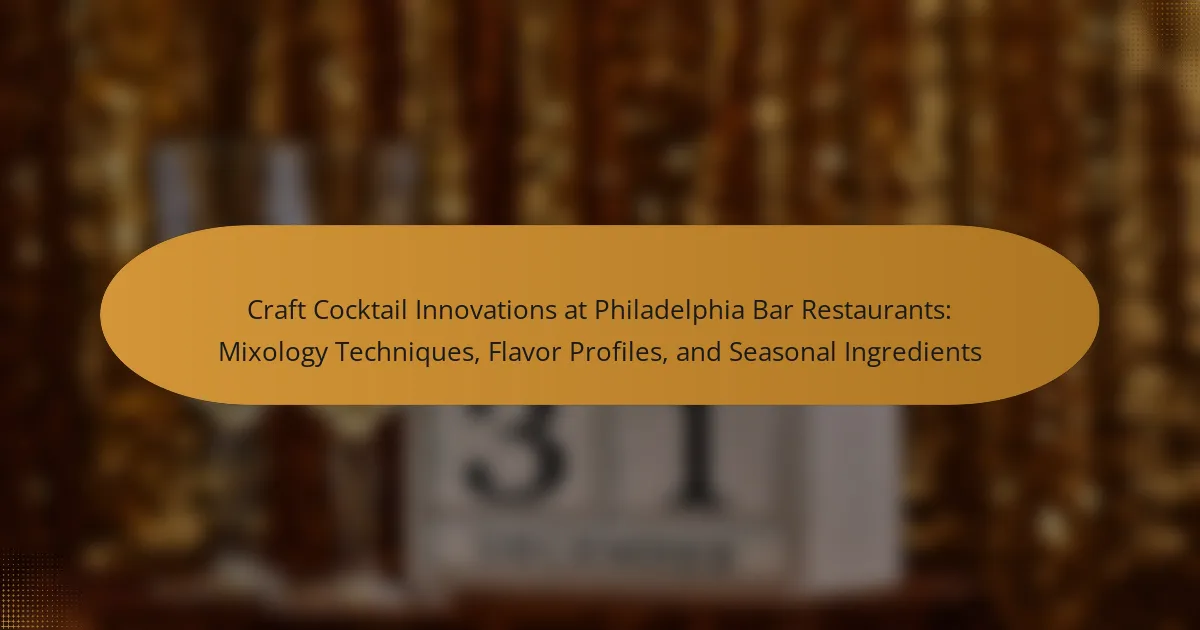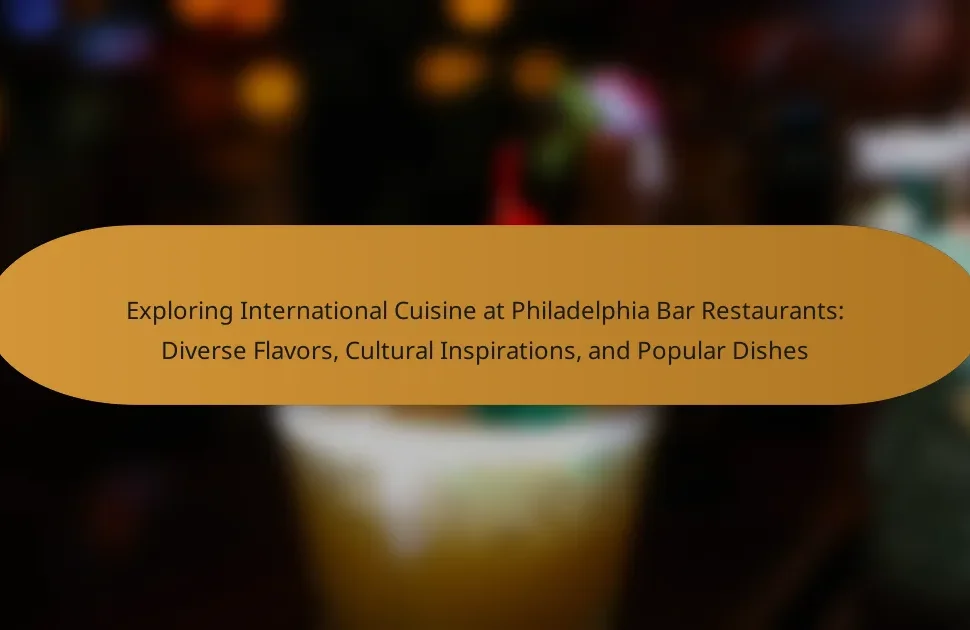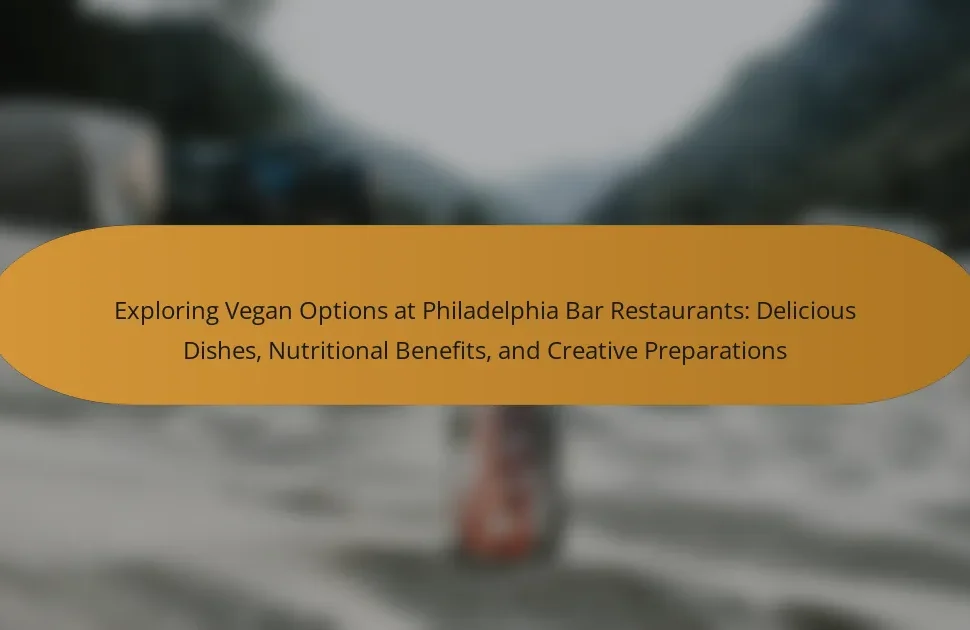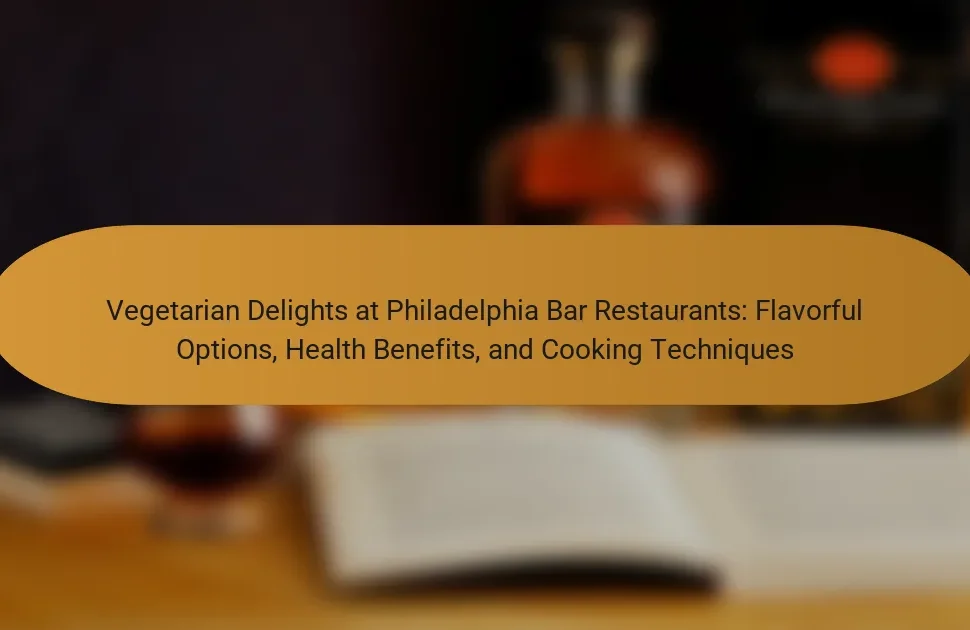
What are Craft Cocktail Innovations in Philadelphia Bar Restaurants?
Craft cocktail innovations in Philadelphia bar restaurants include unique flavor combinations and advanced mixology techniques. Bars are experimenting with local ingredients to create distinctive drinks. Seasonal produce often influences cocktail menus, enhancing freshness and taste. Techniques such as barrel-aging and smoking are gaining popularity. Additionally, some establishments are incorporating molecular gastronomy elements into their cocktails. These innovations reflect a growing trend towards artisanal and crafted beverages. The focus on craftsmanship elevates the overall drinking experience in Philadelphia’s vibrant bar scene.
How do these innovations enhance the mixology experience?
Innovations in mixology enhance the experience by introducing unique flavor combinations and advanced techniques. These innovations allow bartenders to experiment with ingredients creatively. For example, using molecular gastronomy techniques can transform traditional cocktails into visually stunning presentations. Additionally, seasonal ingredients provide fresh flavors that reflect local produce availability. This approach engages customers with the concept of farm-to-glass cocktails. Enhanced tools, such as precision jiggers and sous-vide infusions, improve consistency and quality in drink preparation. These innovations also foster a more interactive experience for patrons, encouraging them to explore new tastes. Overall, they elevate the craft of cocktail making, making it a more dynamic and engaging experience for consumers.
What are the key elements of innovative mixology techniques?
Innovative mixology techniques focus on creativity, precision, and unique flavor combinations. These techniques often incorporate molecular gastronomy, which uses scientific methods to transform ingredients. Additionally, the use of fresh, seasonal ingredients enhances flavor profiles. Innovative mixologists often experiment with various textures and temperatures to create unique drinking experiences. Techniques like infusion, clarification, and carbonation are commonly employed. The presentation of cocktails also plays a crucial role in innovation. Using unconventional glassware or garnishes can elevate the drinking experience. Overall, these elements work together to redefine traditional cocktail-making.
How do local influences shape cocktail creations?
Local influences significantly shape cocktail creations by incorporating regional ingredients and cultural traditions. Philadelphia’s diverse culinary landscape inspires mixologists to blend local flavors into their drinks. Seasonal ingredients sourced from nearby farms enhance freshness and authenticity. Unique local spirits, such as those from local distilleries, contribute distinct profiles to cocktails. Cultural celebrations and historical events also influence recipe development. For instance, cocktails may reflect the city’s rich history or specific neighborhoods. This fusion of local elements creates innovative drinks that resonate with patrons. Ultimately, local influences result in cocktails that are not only unique but also representative of Philadelphia’s vibrant culture.
What role do flavor profiles play in craft cocktails?
Flavor profiles are essential in craft cocktails as they define the overall taste experience. They guide the selection of ingredients, balancing sweetness, acidity, bitterness, and umami. A well-crafted flavor profile enhances the drink’s complexity and appeal. For instance, a cocktail may combine citrus notes with herbal elements to create a refreshing balance. Flavor profiles also influence customer preferences and trends in mixology. Seasonal ingredients are often integrated to reflect local flavors and freshness. This approach not only elevates the drink but also supports sustainability in sourcing. Ultimately, flavor profiles are crucial for creating memorable and unique craft cocktails.
What are the most popular flavor profiles in Philadelphia’s cocktail scene?
The most popular flavor profiles in Philadelphia’s cocktail scene include citrus, herbal, and spicy notes. Citrus flavors often come from fresh fruits like lemon and orange. Herbal profiles frequently feature ingredients such as basil and mint. Spicy notes are commonly derived from peppers or infused spirits. Additionally, local ingredients enhance these profiles, reflecting the region’s agricultural diversity. Seasonal variations also influence flavor choices, with fall cocktails incorporating apple and cinnamon. This trend connects to Philadelphia’s craft cocktail culture, emphasizing innovation and quality.
How can unique flavor combinations elevate a cocktail?
Unique flavor combinations can elevate a cocktail by enhancing its complexity and appeal. These combinations create a multi-dimensional taste experience. For example, pairing citrus with herbal notes can balance sweetness and acidity. This balance can lead to a more refreshing drink. Additionally, unique flavors can surprise and engage the palate. They invite exploration and curiosity from the drinker. Studies show that innovative flavor pairings can increase customer satisfaction. This satisfaction often leads to repeat orders and positive word-of-mouth. Therefore, unique flavor combinations are essential in craft cocktail innovation.
Why are seasonal ingredients important in cocktail crafting?
Seasonal ingredients are important in cocktail crafting because they enhance flavor and freshness. Using ingredients at their peak ripeness ensures optimal taste and quality. Seasonal items often reflect local agricultural cycles, supporting regional farmers and sustainability. This practice also allows for creativity and innovation in mixology. Cocktails made with seasonal ingredients can offer unique flavor profiles that change throughout the year. For instance, fresh berries in summer provide vibrant flavors, while citrus fruits in winter add brightness. Seasonal ingredients can also evoke a sense of place and time, enhancing the overall drinking experience.
How do seasonal ingredients affect flavor and presentation?
Seasonal ingredients significantly enhance flavor and presentation in cocktails. Fresh, in-season produce tends to have more vibrant flavors and aromas. For example, summer fruits like peaches and berries add sweetness and acidity. These ingredients can also improve the visual appeal of cocktails with their bright colors.
Using seasonal herbs, such as basil or mint, provides aromatic depth. Seasonal ingredients often reflect local terroir, creating a unique sense of place in each drink. Additionally, incorporating these ingredients can lead to innovative mixology techniques, such as infusions or muddling.
Research shows that cocktails made with fresh, seasonal ingredients are more likely to attract customers seeking authentic experiences. This trend aligns with the farm-to-table movement, emphasizing quality and sustainability in food and drink.
What are some examples of seasonal ingredients used in Philadelphia cocktails?
Seasonal ingredients used in Philadelphia cocktails include local fruits, herbs, and spices. In spring, strawberries and rhubarb are popular choices. Summer cocktails often feature peaches and basil. Fall brings apples and cinnamon into the mix. Winter cocktails might use cranberries and rosemary. These ingredients reflect the local harvest and enhance flavor profiles. Many bars source these ingredients from nearby farms. This practice supports local agriculture and promotes freshness.
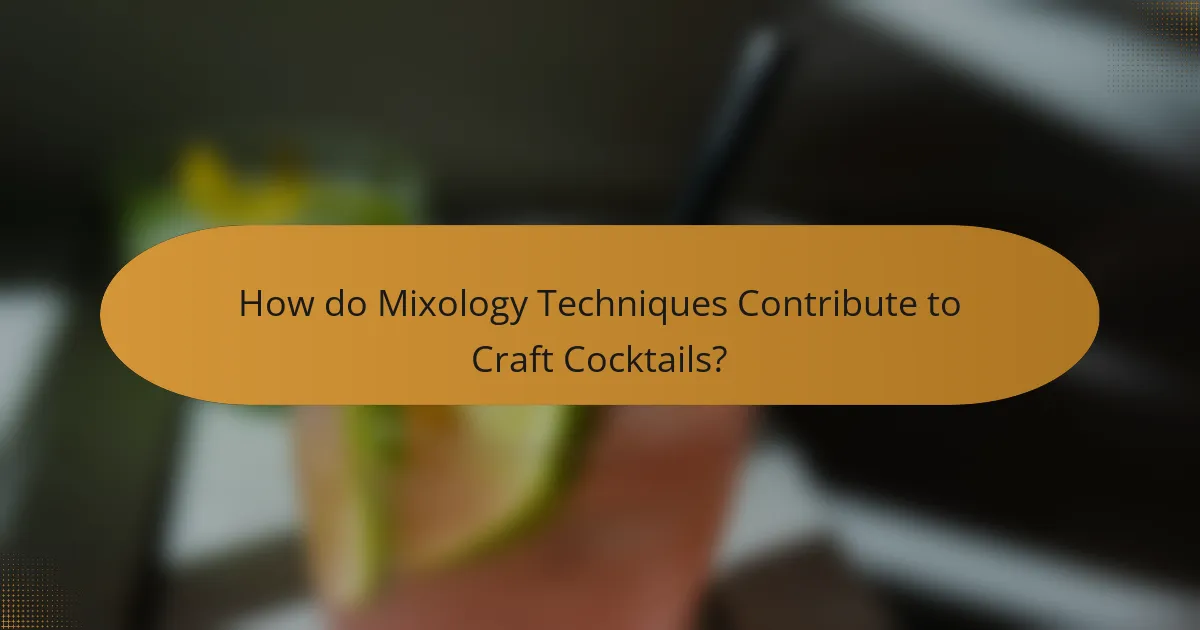
How do Mixology Techniques Contribute to Craft Cocktails?
Mixology techniques enhance craft cocktails by refining flavor, presentation, and overall experience. Techniques such as shaking, stirring, and muddling allow for precise control over ingredient integration. This results in balanced flavors and optimal dilution. Additionally, techniques like layering and garnishing elevate the visual appeal of cocktails. The use of fresh ingredients through techniques like infusing and macerating brings seasonal flavors to the forefront. Historical practices in mixology, such as the use of bitters, add complexity to flavor profiles. Ultimately, these techniques contribute to the artistry and innovation seen in craft cocktails at establishments like those in Philadelphia.
What are the foundational mixology techniques utilized in Philadelphia bars?
Foundational mixology techniques utilized in Philadelphia bars include shaking, stirring, muddling, and layering. Shaking combines ingredients with ice to chill and aerate cocktails. This technique is essential for drinks that include juices or egg whites. Stirring is used for spirit-forward cocktails, ensuring they are chilled without dilution. Muddling involves crushing ingredients, often herbs or fruits, to release their flavors. Layering creates visually appealing drinks by carefully pouring ingredients to maintain distinct layers. These techniques are fundamental in crafting innovative cocktails that highlight flavors and presentation.
How does shaking vs. stirring impact the cocktail’s outcome?
Shaking and stirring impact a cocktail’s outcome by altering its texture, dilution, and temperature. Shaking incorporates air, resulting in a frothy texture and a colder drink. This method is ideal for cocktails with juice or cream, as it emulsifies ingredients effectively. Stirring, on the other hand, maintains a smoother texture and is typically used for spirit-forward cocktails. This technique results in less dilution and preserves the clarity of the drink. According to a study by the Cocktail Chemistry team, shaking can increase the dilution level by 30% compared to stirring. Therefore, the choice between shaking and stirring directly influences the final flavor profile and mouthfeel of the cocktail.
What techniques are unique to Philadelphia’s craft cocktail scene?
Philadelphia’s craft cocktail scene features unique techniques such as the use of locally sourced ingredients and creative infusions. Bartenders often incorporate regional flavors, like using Pennsylvania herbs and fruits. They also emphasize house-made mixers, including syrups and bitters, to enhance flavor profiles. Another technique is the use of unconventional ice forms, like large cubes or artisan ice shapes, which affect dilution and presentation. Additionally, many Philadelphia bars utilize barrel-aging for cocktails, adding depth and complexity. These techniques reflect the city’s commitment to innovation and local culture in mixology.
How can bartenders innovate using traditional techniques?
Bartenders can innovate using traditional techniques by incorporating modern flavors and presentation styles. They can blend classic recipes with unique ingredients like herbal infusions or exotic fruits. Techniques such as barrel-aging can add depth to familiar cocktails. Additionally, using molecular gastronomy can transform textures and enhance sensory experiences. Bartenders can also experiment with traditional garnishing methods by adding unexpected elements. Seasonal ingredients can be utilized to create fresh twists on classic cocktails. This approach not only respects tradition but also attracts a diverse clientele. Historical trends show that innovation in mixology often leads to increased customer engagement and satisfaction.
What are some examples of modern twists on classic cocktails?
Examples of modern twists on classic cocktails include the Smoked Old Fashioned, which incorporates smoked wood for a rich flavor. The Espresso Martini has gained popularity, adding coffee to the traditional vodka base. A Spicy Margarita introduces jalapeños for heat, enhancing the classic recipe. The Lavender Gin and Tonic features floral notes, offering a refreshing variation. The Mezcal Negroni replaces gin with mezcal, introducing a smoky element. Each of these cocktails showcases innovative ingredients while maintaining their classic roots.
How does experimentation with techniques lead to unique drink offerings?
Experimentation with techniques leads to unique drink offerings by allowing mixologists to innovate flavor combinations and presentation styles. This process encourages creativity in ingredient selection and pairing. For example, using molecular gastronomy techniques can transform traditional cocktails into visually stunning creations. Techniques like infusing spirits or creating flavored syrups enhance the depth of flavors. Additionally, experimenting with different mixing methods, such as shaking versus stirring, can alter the drink’s texture and taste. Seasonal ingredients further inspire unique offerings by incorporating fresh, local produce. This approach not only diversifies the menu but also engages customers with novel experiences. Ultimately, the blend of innovative techniques and fresh ingredients results in distinctive cocktails that reflect the bar’s identity.
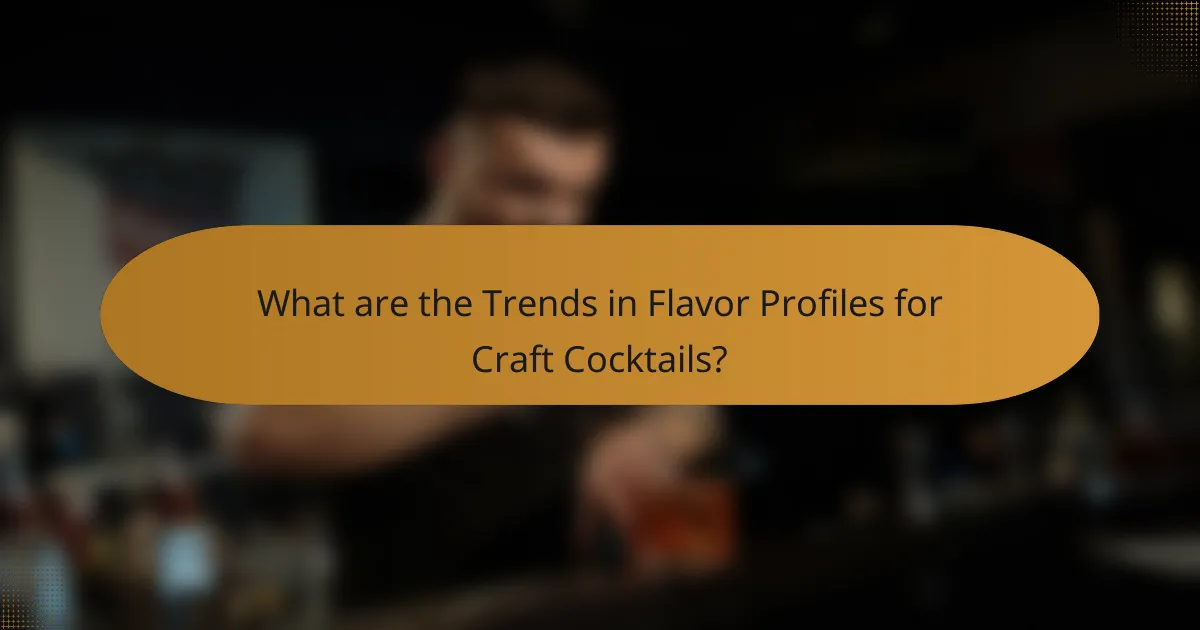
What are the Trends in Flavor Profiles for Craft Cocktails?
Current trends in flavor profiles for craft cocktails include the use of herbal, floral, and spicy ingredients. Bartenders are increasingly incorporating fresh herbs like basil and rosemary into their drinks. Floral elements such as elderflower and hibiscus are gaining popularity for their aromatic qualities. Spicy flavors from ingredients like jalapeño or ginger are being added to create a kick. Additionally, there is a growing trend towards using locally sourced and seasonal ingredients. This focus enhances the freshness and uniqueness of cocktails. The rise of low-sugar and health-conscious options is also notable. Many consumers are seeking cocktails with natural flavors and fewer artificial additives. These trends reflect a shift towards more complex and nuanced flavor experiences in craft cocktails.
How do flavor trends evolve in the craft cocktail industry?
Flavor trends in the craft cocktail industry evolve through consumer preferences and cultural influences. As patrons seek unique experiences, bartenders innovate with new ingredients and techniques. Seasonal availability of fruits and herbs also drives flavor adaptation. Additionally, global culinary trends introduce exotic flavors into cocktails. Social media amplifies these trends, showcasing creative mixes. Craft cocktail competitions further encourage experimentation among mixologists. Data from industry reports indicate a growing demand for sustainable and locally sourced ingredients. This shift reflects broader environmental awareness among consumers.
What are the current trending flavors in Philadelphia’s cocktail bars?
Current trending flavors in Philadelphia’s cocktail bars include citrus, herbal, and spicy profiles. Citrus flavors, such as grapefruit and lime, are popular for their refreshing quality. Herbal notes, particularly from ingredients like basil and rosemary, enhance complexity. Spicy elements, including jalapeño or ginger, add a kick to cocktails. Seasonal ingredients also play a role, with local fruits and vegetables influencing flavor choices. These trends reflect a broader movement towards fresh, vibrant, and innovative cocktails in the city’s bar scene.
How do bartenders incorporate global flavors into local cocktails?
Bartenders incorporate global flavors into local cocktails by using diverse ingredients and techniques from various cultures. They often source spices, herbs, and fruits that reflect international cuisines. For example, they might use Japanese yuzu in a citrus-forward drink. Additionally, bartenders may employ techniques like muddling or infusing to enhance flavors. They often experiment with global spirits, such as mezcal or sake, to add unique profiles. Seasonal ingredients also play a role in creating globally inspired cocktails. This approach allows for a fusion of tastes that resonate with local clientele while introducing them to global influences.
What are the best practices for balancing flavors in cocktails?
To balance flavors in cocktails, use a combination of sweet, sour, bitter, and umami elements. Sweetness can be achieved with syrups or liqueurs. Sourness typically comes from citrus juices like lemon or lime. Bitterness can be introduced through bitters or certain spirits. Umami can be found in ingredients like vermouth or certain fruit purees.
Start by establishing a base flavor. This could be a spirit or a prominent ingredient. Gradually add other elements while tasting frequently. Aim for a harmonious blend where no single flavor overpowers the others. Adjust sweetness and acidity to achieve balance.
Research indicates that well-balanced cocktails enhance the overall drinking experience. According to a study published in the Journal of Food Science, a balanced flavor profile can significantly improve consumer satisfaction.
How can bartenders achieve a harmonious flavor profile?
Bartenders can achieve a harmonious flavor profile by balancing complementary flavors. This involves understanding the five basic taste categories: sweet, sour, bitter, salty, and umami. Each cocktail should incorporate ingredients that enhance rather than overpower each other. For example, a sweet syrup can be balanced with citrus juice to create a refreshing contrast. Additionally, using fresh herbs can add complexity without overwhelming the palate. Bartenders often taste their creations at various stages to ensure balance. Studies show that balanced flavor profiles enhance the overall drinking experience, leading to increased customer satisfaction.
What common mistakes should be avoided when mixing flavors?
Common mistakes to avoid when mixing flavors include overusing strong ingredients. This can overpower the drink and mask subtle flavors. Another mistake is neglecting balance between sweet, sour, and bitter elements. A well-balanced cocktail enhances the overall experience. Additionally, failing to consider the temperature of ingredients can lead to undesirable results. Cold ingredients can dilute flavors, while warm ingredients may alter the intended taste. Not experimenting with complementary flavors can also limit creativity. Understanding flavor pairings is essential for innovation. Lastly, ignoring the importance of dilution can affect the cocktail’s texture and mouthfeel. Proper dilution ensures a smooth drinking experience.
What practical tips can enhance the craft cocktail experience?
Use high-quality ingredients to enhance the craft cocktail experience. Freshly squeezed juices provide superior flavor compared to bottled options. Premium spirits elevate the overall taste of the cocktail. Incorporating seasonal ingredients adds unique flavors and freshness. Experiment with different garnishes for visual appeal and aromatic enhancement. Utilize proper glassware to enhance the drinking experience. Chilling glassware before serving maintains optimal temperature. Lastly, mastering basic techniques like shaking and muddling improves cocktail consistency and quality.
How can home bartenders apply professional techniques?
Home bartenders can apply professional techniques by mastering essential skills and using quality ingredients. They should learn to properly measure spirits and mixers using jiggers for accuracy. This ensures balanced flavors in cocktails. Additionally, bartenders can practice various shaking and stirring methods to achieve the desired texture and temperature.
Using fresh, seasonal ingredients enhances the flavor profile of cocktails. Home bartenders should also experiment with garnishes to elevate presentation. Knowledge of classic cocktail recipes provides a solid foundation. Understanding the importance of glassware can improve the overall experience.
Finally, continuous practice and experimentation with flavors will refine their skills. Engaging with online mixology communities can offer valuable insights and techniques. This approach mirrors professional bartending practices, leading to improved cocktail quality.
What resources are available for learning about craft cocktails?
Books on craft cocktails are excellent resources for learning. Titles like “The Craft of the Cocktail” by Dale DeGroff provide foundational knowledge. Online courses from platforms like MasterClass offer video tutorials from industry experts. Websites such as Liquor.com feature articles and recipes for various cocktails. Additionally, local workshops and classes at bars or culinary schools enhance hands-on experience. Social media platforms, particularly Instagram, showcase trends and techniques in real-time. Finally, YouTube channels dedicated to mixology provide visual guidance and tips.
Craft cocktail innovations at Philadelphia bar restaurants focus on unique flavor combinations, advanced mixology techniques, and the use of seasonal ingredients. The article explores how these innovations enhance the mixology experience, highlighting key techniques such as infusion and molecular gastronomy. It also examines the impact of local influences on cocktail creations and the importance of balanced flavor profiles. Additionally, the article discusses trends in flavor profiles, best practices for mixing, and resources for learning about craft cocktails. Overall, it provides a comprehensive overview of the dynamic craft cocktail scene in Philadelphia.
